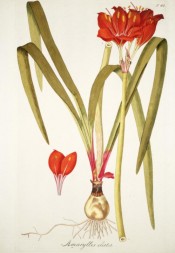Cyrtanthus elatus (Jacq.) Traub
Deciduous, sometimes evergreen perennial with erect, strap-shaped leaves and up to 9 open funnel-shaped bright scarlet flowers in late summer. In the wild they often flower after fire. To 60cm by 10cm. There are a number of varieties. [CECB, RHSE, Hortus].
Horticultural & Botanical History
The first botanical description appears to be that of the younger Linnaeus in 1782, as Crinum speciosum [Suppl. Pl. p.195/1782]. Described as Amaryllis purpurea by Aiton in 1789 [Hort. Kew. vol.1, p.417/1789] and as Amaryllis elata by Jacquin in 1797 [Jacquin Sch. vol.1, p.32/1797]. Placed in Cyrtanthus by Herbert in 1819 as Cyrtanthus purpureus [BM t.2113/1819], following Aiton’s nomenclature. Named Cyrtanthus elatus by Traub in 1969 [Plant life vol.25, p.48/1969], the name by which it is generally known today.
‘There are few plants so showy and useful as this which are so suitable for amateurs, or persons possessing but limited accommodation for plant growing. It is more beautiful than many varieties of Amaryllis, while it is not nearly so troublesome to manage; and its fine umbels of bright-coloured flowers last in perfection for weeks in a cool greenhouse.’ [Gard. Chron. 1854]. The Botanical Register, discussing Amaryllis purpurea var. minor said that it was ‘introduced by Mr. Masson from the Cape of Good Hope in 1774.’ [BR f.552/1821]. Jacq. Sch. pl.62/1797-04.
History at Camden Park
Introduced to the gardens before 1843. Listed in all published catalogues [B.441/1843].
Notes
Published May 08, 2009 - 02:56 PM | Last updated Jul 09, 2012 - 01:02 PM
| Family | Amaryllidaceae |
|---|---|
| Category | |
| Region of origin | South Africa |
| Synonyms |
|
| Common Name | Scarborough lily, George lily |
| Name in the Camden Park Record | Vallota purpurea
|
| Confidence level | high |
